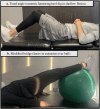Current Rehabilitation Principles Following Meniscus Repairs
- PMID: 40343689
- PMCID: PMC12283527
- DOI: 10.1007/s12178-025-09967-6
Current Rehabilitation Principles Following Meniscus Repairs
Abstract
Purpose of review: The purpose of this review is to synthesize current science on meniscus anatomy and biomechanics and repair techniques to create an empirical foundation for postoperative rehabilitation precautions and guidelines, including timelines, clinical and performance-based criteria for return to activity, to maximize both meniscal healing potential and patient recovery.
Recent findings: Recent literature has focused on meniscus repair rather than debridement, and rehabilitation protocols should be designed to optimize healing. Complex, unstable tears, like root and radial tears, disrupt hoop stress and warrant a more conservative protocol including 6 weeks of non-weightbearing; however, more stable tears, like ramp and vertical tears, can often weight bear immediately after surgery. All protocols should emphasize early protected joint motion. Return to activity guidelines remain ill-defined but this review explores evidence-based recommendations for timelines, strength and performance testing. Patients typically should wait ≥ 4 months for a return to activity and the presence of joint line tenderness or effusion could be a sign of delayed/failed healing. It is essential for therapists to know the size, type, and location of a meniscus repair to optimize patient outcomes. Guidelines for weight bearing, range of motion, strength training, and return to activity should vary per tear type and repair technique and recovery should be both time- and criteria-based. Return to activity should align with healing time, objective clinical and performance testing, and clinical and imaging exam findings. Future research should aim to optimize repair techniques and rehabilitation protocols, specifically further study on the timing to initiate weightbearing, early motion, and return to activity.
Keywords: Knee; Meniscus; Meniscus repair; Meniscus root tear; Radial tear; Rehabilitation.
© 2025. The Author(s), under exclusive licence to Springer Science+Business Media, LLC, part of Springer Nature.
Conflict of interest statement
Declarations. Human and Animal Rights and Informed Consent: All reported studies/experiments with human or animal subjects performed by the authors have been previously published and complied with all applicable ethical standards(including the Helsinki declaration and its amendments, institutional/national research committee standards, and international/national/institutional guidelines). Conflict of Interest: Jill Monson, PT, OCS: Financial Disclosure and Conflict of Interest. —Consultant: Ossur, Smith & Nephew -Committees: AASPT Research Committee. Dr. Robert F. LaPrade, MD, PhD: Financial Disclosure and Conflict of Interest.—Consultant: Ossur, Smith & Nephew, Responsive Arthroscopy—Royalties: Ossur, Smith & Nephew, Elsevier, Arthrex—Research Grants: Ossur, Smith & Nephew, AANA, AOSSM—Committees: ISAKOS, AOSSM, AANA—Editorial Board: AJSM, JEO, KSSTA, JKS, JISPT, OTSM—Education: Foundation Medical. Luke Tollefson, BS: No Financial Disclosures and Conflict of Interest. Dr. Christopher M. LaPrade, MD: Financial Disclosure and Conflict of Interest. Educational support: Evolution Surgical, Inc, Foundation Medical, LLC, Arthrex, and Smith & Nephew. Speaker fees from DJO.
Figures








References
-
- Aman ZS, DePhillipo NN, Storaci HW, Moatshe G, Chahla J, Engebretsen L, et al. Quantitative and Qualitative Assessment of Posterolateral Meniscal Anatomy: Defining the Popliteal Hiatus, Popliteomeniscal Fascicles, and the Lateral Meniscotibial Ligament. Am J Sports Med. 2019;47(8):1797–803. 10.1177/0363546519849933. - PubMed
-
- LaPrade CM, Ellman MB, Rasmussen MT, James EW, Wijdicks CA, Engebretsen L, et al. Anatomy of the anterior root attachments of the medial and lateral menisci: a quantitative analysis. Am J Sports Med. 2014;42(10):2386–92. 10.1177/0363546514544678. - PubMed
-
- DePhillipo NN, Moatshe G, Chahla J, Aman ZS, Storaci HW, Morris ER, et al. Quantitative and Qualitative Assessment of the Posterior Medial Meniscus Anatomy: Defining Meniscal Ramp Lesions. Am J Sports Med. 2019;47(2):372–8. 10.1177/0363546518814258. - PubMed
-
- Johannsen AM, Civitarese DM, Padalecki JR, Goldsmith MT, Wijdicks CA, LaPrade RF. Qualitative and quantitative anatomic analysis of the posterior root attachments of the medial and lateral menisci. Am J Sports Med. 2012;40(10):2342–7. 10.1177/0363546512457642. - PubMed
Publication types
LinkOut - more resources
Full Text Sources
Research Materials

